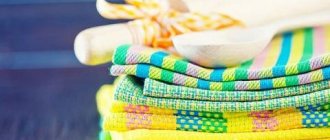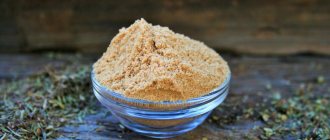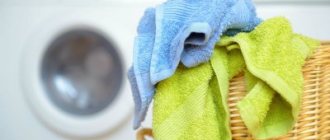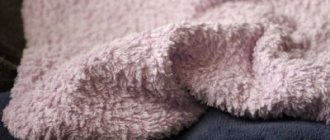The kitchen is the face of the housewife. How important it is to keep the stove, refrigerator or sink clean. But while cleaning a kettle and microwave is not particularly difficult, dealing with dirty kitchen towels at home is usually very difficult. However, there are interesting and effective ways in which you can bleach and wash kitchen linen with ordinary mustard. All you need for this is mustard powder and water.
Weekly towels are good helpers for the clean housewife
How it works
Kitchen towels get dirty at an unusual rate. Especially when it comes to the cooking process. The most popular contaminants on such products are traces of fat, fruit syrups, fruit drinks and juices. Each of these stains is not easy to remove, so bleaching the towel should be at a high level.
An ingredient such as mustard is often found in various recipes for combating excess weight, treating oily skin and hair. It was the ability to cope with fat that became the basis for trying this spice in washing kitchen towels.
In addition, the powder has other beneficial properties. Mustard during cleaning will also help restore whiteness to products and disinfect. There are several ways to use mustard to restore kitchen utensils to their almost original appearance.
Adviсe
To keep your towels clean longer, follow these recommendations:
- use several types of towels in the kitchen: for hands, for tables, etc.;
- before wiping your hands on a towel, at least rinse them, or better yet, wash them;
- wipe off greasy stains with paper towels;
- You should wash kitchen towels at least once a week;
- Try not to use terry towels in the kitchen. It is very difficult to wash them.
Soaking with mustard
Before starting the process, it is important to prepare for the fact that washing kitchen towels with mustard will give a good result only if the spice comes into long-term contact with the fabric fibers and dirt on them. Therefore, you need to calculate the number of clean specimens in the kitchen in advance.
How to restore cleanliness to towels using mustard:
- Take a large saucepan and pour water into it. For small specimens, 5 liters of liquid will be enough.
- Bring water to a boil.
- After this, add 5 tbsp to the water. l dry mustard.
- The mixture is thoroughly stirred and left for some time.
- The powder must settle.
- Then strain the water so that no grains remain.
- Dip the prepared items into the resulting mustard water.
- Leave for 2 hours.
- Rinse the products in clean warm water 3-5 times.
If you want to give your products extra freshness, you can wash them in the washing machine afterwards. For dense natural fabrics, set the Cotton program or another mode in which the water is heated to 60 degrees. At the end of the process, dry the items in the fresh air.
Alternative ways to wash items
In addition to mustard powder, the following methods are used as a bleach:
- Ammonia has a characteristic odor of ammonia. Washing with ammonia means taking care of the quality of the product and trying to increase the service life of the product. It can be used as a means to soften hard water, 1 tablespoon per bucket of water. Ammonia helps maintain the brightness of colored items; when rinsed and washed, white fabrics acquire their original whiteness.
- Hydrogen peroxide is an affordable home remedy for removing stains. It is indispensable for removing dirt from the surface of delicate fabrics. To remove stains and whiten, dilute 1 teaspoon of peroxide in 2 liters of warm water. The fabric is soaked in the prepared solution for 20 minutes, stirring occasionally.
- Laundry soap is used by housewives who know a lot about whitening things. It removes difficult stains. Before use, the soap is crushed using a grater or knife. Difficult stains are washed out before washing, or soap is dissolved in water, and the damaged fabric is soaked for an hour or two.
- Boiling. One of the common bleaching methods is boiling. Water is poured into a metal container, 10 liters per kilogram of laundry. During boiling, it is possible to add grated laundry soap. Boil the laundry for half an hour to three hours.
- Baking soda is suitable for removing “old” stains. A noticeable effect appears when using soda with ammonia.
- Salt. Mustard cannot be used to remove stains left by tomato and coffee drinks, but a saline solution does the job. For one liter of cold (room) water, 1 tablespoon of table salt, soak the soiled item for 3 hours, wash as usual.
There is no need to use expensive products to keep your kitchen clean. “Grandma’s” recipes using mustard will help you cope with the task.
The article has been verified by the editors
Washing white towels and bleaching
This method will help get rid of stubborn stains, but will require even more time. To wash kitchen towels and restore their whiteness:
- Take 1 package of dry mustard. Pour into a small bowl.
- Gradually add warm water and stir.
- The result should be a paste with a consistency similar to thick sour cream.
- Apply the resulting solution to the towels over the entire surface.
- Place the coated product in a plastic bag and tie it.
- Mash it a little in your hands to make the powder work better.
- Leave the towel on for 4 hours.
- After the time has passed, remove the product and rinse thoroughly in cool water.
Mustard will dissolve all existing dirt, return whiteness and all that remains is to wash it in any convenient way.
You can also soak the napkins for a long time. To do this, add the powder to warm water and stir. You need to place the items to be washed into the resulting solution. To achieve a good result, you will have to leave things to soak for 12 hours. Therefore, it is better to do this procedure at night.
In the morning, you need to rinse the towel thoroughly several times and load the laundry into the washing machine.
Soap root for washing
Soaproot is the rhizome of soapwort or saponaria, a plant widely grown throughout Eurasia and Russia. Interestingly, along with the production of soap root, soapwort is also used to produce oriental sweets such as Turkish delight and halva.
Compared to other natural laundry detergents, soap root may take a little longer to apply. It is used in the same way as mustard powder for washing silk and wool, but unlike mustard it produces noticeable foam.
You can prepare soap root yourself or purchase it at a pharmacy.
A day before washing, you need to soak 50 grams of soap root in hot water. The next day, boil the solution for about an hour over low heat, let it sit and strain through cheesecloth. After this, it can be used for washing.
To save money with the remaining root, you can repeat the procedure (soak for a day, boil, strain) - the solution will be less concentrated, but will also provide a good opportunity to wash things.
After washing, clothes should be rinsed thoroughly in warm water.
Soap root solution cannot be stored, but must be used immediately after preparation, as it tends to quickly deteriorate.
Strengthening the method by soaking
To ensure that the mustard begins to act faster, the contaminant can be softened first. A simple soaking will help do this.
The procedure is as follows:
- Fill a small basin with warm or hot water.
- Place your laundry in it.
- You can also wash it by hand using laundry soap.
- Rinse thoroughly.
- Boil a bucket of water.
- Pour 1 package of powder into it.
- Add 50 g of your favorite washing powder or washing gel.
- Mix everything thoroughly.
- Leave the soiled items in the resulting mixture for 3 hours.
- Wash in any convenient way.
After this, you can start drying. Kitchen towels washed in this way will get rid of stubborn and stubborn stains.
If kitchen napkins are not only heavily stained, but also have specific odors, one simple remedy will help. You just need to add 100 ml of vinegar during the last rinse. It not only neutralizes odors, but also has an additional disinfecting effect.
Important Rules
- To maintain the strength of kitchen cloth napkins, you should wash them in boiling water and using special products no more than once a month.
- To control the cleanliness of kitchen items at home, have several sets of work towels. They need to be washed more often, without waiting for serious old and difficult to remove stains.
- It is better to wipe a dirty table and stove surface with paper napkins or microfiber cloths. Use cloth napkins only for wiping your hands and clean plates.
- Terry towels are not the best option for the kitchen. They are a source of bacterial growth and are more difficult to wash and bleach even with mustard. In addition, thick terry napkins absorb food odors for a long time.
- Washed, dry fabric napkins need ironing - this will prolong their fresh appearance.
- Do not put dry kitchen utensils in the closet - mold may appear.
Snow-white, well-washed towels lift your spirits
Original and cheap methods of washing and bleaching kitchen towels with mustard powder or oil are surprising in their effectiveness and bring back the joy of crystal cleanliness to your home. These options are ideal for families with small children where disinfection is necessary, as well as for people who suffer from allergies to chemical laundry detergents.
Removing stains from leather products
There are several ways to save a leather jacket, bag or trousers.
But, before you start cleaning the product, you should clear the area of contamination from dust and other debris. What methods exist:
- baby powder/flour/crushed chalk: if the trace of fat is still fresh, then moisten it a little with a wet cloth, sprinkle any of the suggested products on top, leave for half an hour and then gently brush off with a soft brush;
- onion: helps remove grease from colored leather items. To do this, cut the onion in half and rub the juice on the stained area. Do this several times until the dripped fat is removed, but each time cut off the old layer of the onion so that clear juice is formed;
- gasoline: copes well with old traces of grease, although you need to work with it carefully and preferably in a ventilated area. Wipe the greasy mark several times with a cloth soaked in gasoline. The resulting wet spot can be removed with bread crumbs;
- ammonia/milk/laundry soap: grate the soap, add cold milk and ammonia (all ingredients in equal proportions). Using a soft brush or cloth, apply the prepared mixture to the contaminated area. Rub a little and then rinse with a sponge and warm water;
- coffee: coffee grounds effectively remove dirt on leather shoes. Place the paste on the greasy mark and leave to soak for 20 minutes. After this, rub a little with a shoe sponge and wipe with a dry, clean cloth;
- Cleaning agent for washing stoves: does an excellent job of removing old greasy marks left on leather items. It is applied for 1 minute, and then removed with a damp sponge moistened with warm water. Be careful, the gel is strong, so before you start cleaning your favorite item, test it on the underside or in a small area. If the skin does not fade, the test is passed.
Video: How to remove grease stains at home?
Washing soda
In order to successfully deal with stains on all types of fabrics available in the home, of course, you need to have several natural laundry products. calcined clothes are perfect for clothes, as well as bedding made of cotton and linen (namely, plant fibers). soda _
It will easily turn linen sheets and duvet covers into snow-white if you add it to the drum of the washing machine and set the washing temperature from 50 to 70 degrees.
Some tips for bleaching fabric using folk remedies
Folk remedies include different components: from kitchen salt to silicate glue, so they must be used very carefully.
- Before bleaching fabric, apply a small amount of bleach to a small area and let it sit for several hours or overnight. If nothing happened to the fabric during this time, you can safely use the product on other areas.
- Follow the instructions strictly. If you take ingredients by eye, this can lead to unpredictable consequences.
- If the chosen whitening method involves the use of aggressive components (potassium permanganate, acetic acid, hydrogen peroxide, chlorine), carry out the procedure with rubber gloves so as not to harm the skin of your hands. A protective mask will not hurt either, since the listed components emit harmful fumes.
- A large number of bacteria accumulate on kitchen towels, so after washing they must be treated with a solution of acetic acid (0.1 liter of vinegar per 10 liters of water). Thanks to vinegar, 90% of the microbes on the fabric will die.
How to remove chocolate stains
Before you begin removing a chocolate stain, use a plastic knife or spatula to scrape any remaining chocolate from the fabric. Then apply dishwashing liquid (per teaspoon 300 ml of water), then soak in detergent with water-soluble enzymes before the main wash. (Most cleaning products contain them)
Read also: Washing children's clothes: important rules and stupid myths
Washing with soap nuts
Soap nuts have recently become increasingly popular and are becoming available in many regular and online stores, despite their exotic origin.
Soap nuts are the fruits of the soap tree, which grows in America and Asia and has been used in these territories for centuries as a detergent, including for washing fabrics.
It is obvious that this natural laundry detergent, unknown in Russia just a few years ago, has a number of advantages over the rest of its group:
- they can be used with equal effectiveness and safety for any fabric;
- they can be washed in any mode and at any temperature;
- soap nuts have no odor;
- In addition to cleansing, they also soften fabrics.
Soap nuts are placed along with the laundry directly into the drum of the washing machine in a special canvas bag, which is usually included with them upon purchase. For 4-5 kg of laundry, only 7-8 nut shells are enough, which can be used repeatedly until they stop lathering.
How to iron woolen items
- Woolen items should be ironed from the inside out and through a damp cotton cloth. When heated, it is easier to give a wet product the desired shape and size.
- If the products are knitted with a relief pattern, then they should be placed on something soft and ironed through a damp cloth, without pressing too hard with the iron.
- When ironing knitted woolen items, you should also not press the iron. They need to be lightly steamed so as not to stretch the knitting.
- Products made from mohair cannot be ironed. But a rolling pin can help here. You need to lay out a clean towel on the table, and spread the washed item on top of it. Cover with another clean towel on top. Now, pressing firmly, roll it onto the rolling pin. Repeat this several times. Replace the wet towel with a dry one. This method smoothes the fur well, and does not crush the pile.
Care instructions
Getting wipes to their original cleanliness is not always easy. If treated with care, they will last for many years.
A few tricks will help extend their life in the kitchen:
- It is wise to have several (up to a dozen) towels in the kitchen. This will allow you to avoid using one handbrake endlessly. There will be a little bit for everyone. While one is in use, others are in the wash or waiting their turn.
- Unworn wipes are easier to wash. Soaked in mustard solution, they easily remove stains.
- The habit of changing kitchen towels every 2-3 days will allow you to enjoy their cleanliness for a long time. A few days have passed and the handbrake is sent to the wash. Even if no stains are visible, it is wise to do so. You used it, which means you need to wash it. This will be easy to do with mustard.
Washing with salt
Surprisingly, ordinary table salt will not only help refresh summer items made from cotton and linen fabrics, but will also preserve their presentation for a long time even after frequent washing and rinsing. After all, as you know, the main problem with bright blouses bought for the summer is that every now and then you have to wash them just because of the smell of sweat and city dust, and not because of any serious dirt. Due to these frequent washings, they fade very quickly, and the fabric loses its properties. Salt helps solve all these problems.
When washing with table salt, it is important to maintain the proportions: dilute strictly one heaped tablespoon of salt per liter of warm water, and only then can you soak and wash things in the resulting solution.
This method of washing will save money on the purchase of powder and new clothes, and will also not harm the skin of your hands and the environment.
Selection of towels
In order for the handbrake to last a long time and remain snow-white, it is good to follow several rules:
- There is no place for terry towels in the kitchen, as they quickly get dirty. They require a lot of effort when washing and take a long time to dry. Waffle handles are an excellent option for wiping. There are many ways to whiten them efficiently. Cotton or linen handles are good to have on hand;
- Kitchen textiles are not a universal means for drying. In the kitchen there is always a separate wipe for hands, and a separate one for dishes. The table, stove surface, and sink are wiped with either a sponge or a special napkin;
- The more often handbrake handles are washed, the easier it is to do this, since the stains that have settled on them will not have time to settle firmly. With this regime, the owner has a better chance of getting rid of them;
- White handbrake have an advantage over colored handbrake. A stain is immediately detected on them, even a barely noticeable one;
- dirty hands are first washed and then dried. With this order there will be less dirt on the handbrake;
- oily wipes are washed separately from other items;
- Ironing kitchen towels will protect them from subsequent contamination.
Considering these subtleties, you will be able to extend the service life of your kitchen towels. Not only expensive detergents will help in the pursuit of cleanliness in the kitchen. Folk remedies are also good in this matter. In addition, mustard for washing parking brakes is necessary in a house where there are allergy sufferers. The natural product will give your towels whiteness and freshness. The process is simple. Towels are soaked, washed, dried and ironed.
Removing stains from delicate items
The most difficult thing to remove greasy marks from clothes that require special care: silk, guipure, wool.
Methods to help save your favorite things:
- a mixture of water, glycerin and ammonia effectively copes with greasy stains. The ingredients are mixed in equal quantities. To use, dip a napkin in this liquid, apply to the stain and set aside for 10 minutes;
- potato flour (starch): place the contaminated product on a white cloth, pour heated flour on top of the greasy mark, which should absorb the fat. Repeat this every half hour until you achieve the desired effect. After cleaning is complete, agitate the starch with a soft brush.
Removing fresh stains
A fresh stain is easier to remove. The main rule is that you shouldn’t hesitate to deal with greasy stains. And the sooner we begin to remove them, the greater the chance of getting a positive result.
As soon as a greasy stain has formed on the fabric, do the following:
- quickly dip it with a paper napkin, not allowing the fat to spread and be absorbed into the fibers of the fabric;
- sprinkle the resulting stain with coarse table salt so that it absorbs the fat. Change the oiled salt every 10-15 minutes until the grease stain disappears or decreases.
The sooner you start working, the greater the chances of success.











